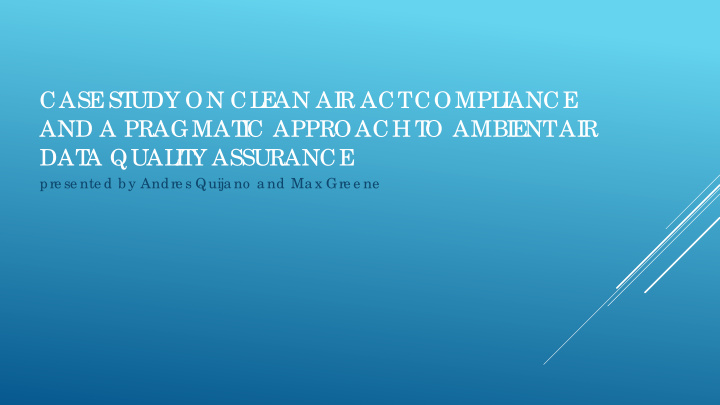



CASE ST UDY ON CL E AN AI R ACT COMPL I ANCE AND A PRAGMAT I C APPROACH T O AMBI E NT AI R DAT A QUAL I T Y ASSURANCE pre se nte d b y Andre s Quija no a nd Ma x Gre e ne
CLEAN AIR ACT OVERVIEW National Ambient Air Quality Standards (NAAQS) State Implementation Plans (SIPs) New Source Performance Standards (NSPS) Prevention of Significant Deterioration (PSD) Non-attainment New Source Review (NSR) 2
CLEAN AIR ACT OVERVIEW PSD & NSR require permits for “construction” of major source of air pollution. “Construction” includes “modification.” “Modification” includes: “Any physical change in, or change in the method of operation of, a stationary source which increases the amount of any air pollutant emitted by such source or which results in the emission of any air pollutant not previously emitted.” 3
AMERICAN ELECTRIC POWER Pre-1977 sources exempt from PSD/NSR permitting until “modification” occurs. EPA regulations exclude “routine maintenance, repair and replacement” from “modification.” Midwestern power plant operators claimed all changes to pre-1977 plants were “routine maintenance, repair and replacement.” The result: emissions from these plants generated ozone, which was transported from the midwest to non-attainment states in the northeast. 4
AMERICAN ELECTRIC POWER 5
AMERICAN ELECTRIC POWER States (including Rhode Island) and others sued under the Clean Air Act. Operator data showed that the plants’ changes were likely “modifications” requiring permits. The result: a settlement worth over $4.6 billion, a significant reduction in emissions from the plants, and ozone improvement in the northeast. Data were key to identifying the path to compliance with the Clean Air Act. 6
HOW CAN WE T RUST T HE DAT A I s it tra c e a b le to a re fe re nc e me tho d? Re pe a ta b ility / T ra c e a b ility I s it tra c e a b le to a re fe re nc e sta nda rd? Ac c ura c y
Pla nning De ployme nt I nsta lla tio n Site Ca lib ra tio n F unding Pro c ure me nt Pre pa ra tio n Ma inte na nc e Da ta Co lle c tio n Re po rting
OPE RAT I ON DAT A
SI X ARE AS OF ANY QUAL I T Y SYST E M Sta tio n L o g Ca lib ra tio n Ce rtific a te s Ma inte na nc e Sc he dule Ma inte na nc e T a sk Sta tio n Se tup
CAL I BRAT I ON CE RT I F I CAT E S Ca lib ra tio n Re fe re nc e Me tho d
CAL I BRAT I ON CE RT I F I CAT E S Pre a nd Po st Ca lib ra tio n Da ta
CAL I BRAT I ON CE RT I F I CAT E S Pa ss F a il Crite ria
MAI NT E NANCE T ASK Che c k L ist
MAI NT E NANCE SCHE DUL E Sc he dule Da te Co mple te d Da te T ype o f Ma inte na nc e Co mme nts Co mple te d b y
ST AT I ON SE T UP
ST AT I ON SE T UP
RE VI E W OF T E N, I NT E RNAL AUDI T I NG Data Collection Data Reporting Data Calculations Data Validation
RE AL T I ME
I NSTANTANEOUS W I ND ROSE
REAL TI ME ALARMS
DAT A RE VI E W AND RE PORT S • Review as often as possible • Document everything you know when you know it • Produce a report that has uncertainty calculation methods location and conditions make sure any exceptions are also documented
QUE ST I ONS ? Max Greene Andres Quijano Conservation Law Foundation American Ecotech 55 Dorrance Street 100 Elm St Providence, RI 02903 Warren RI 02885 P : 401-351-1102, ext. 2013 P : 401-247-0100 E : E : mgreene@clf.org aquijano@americanecotech.com
Recommend
More recommend